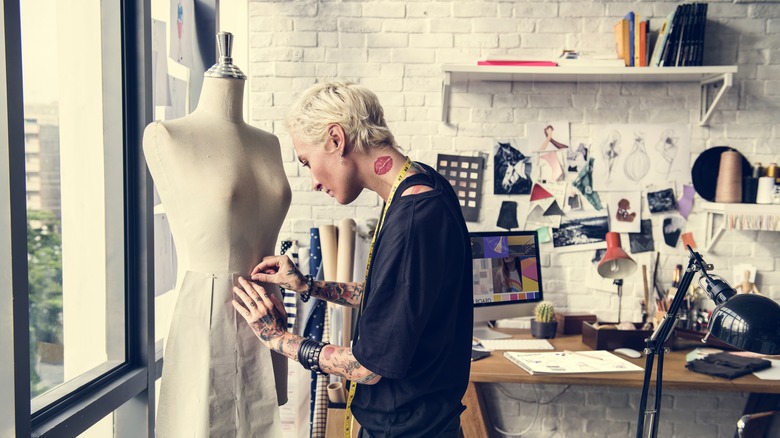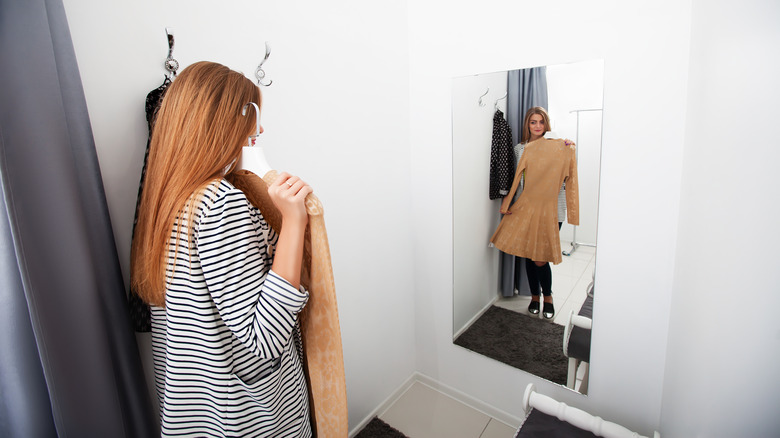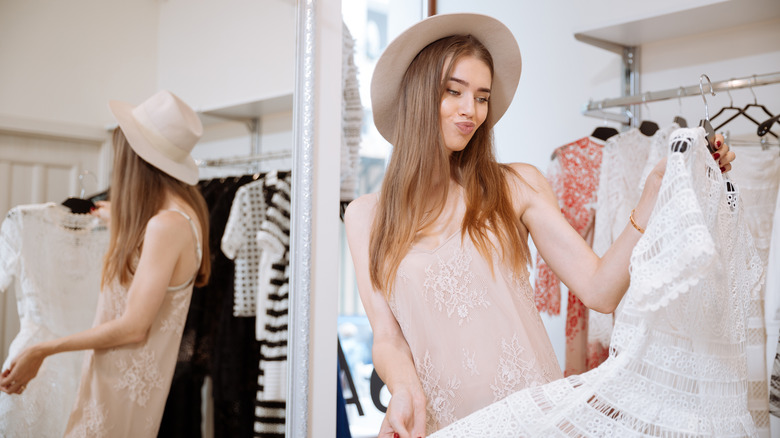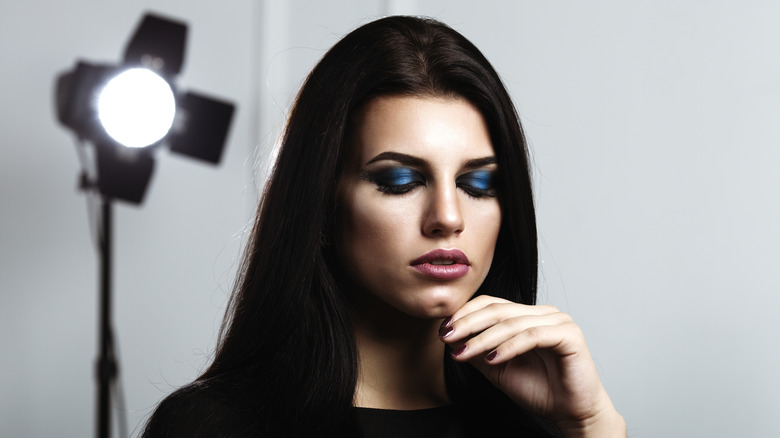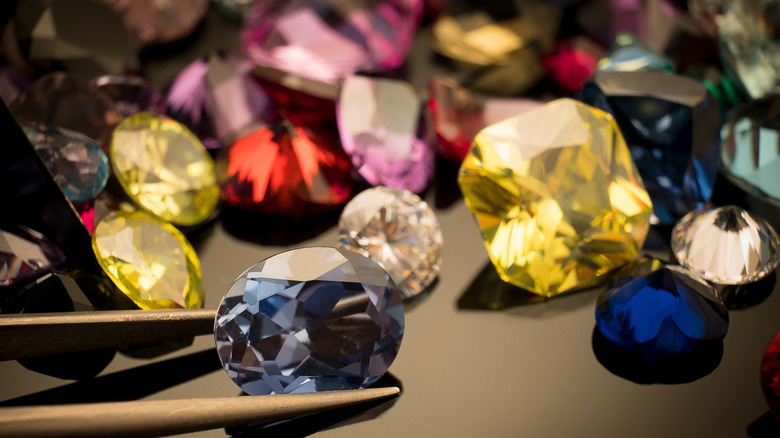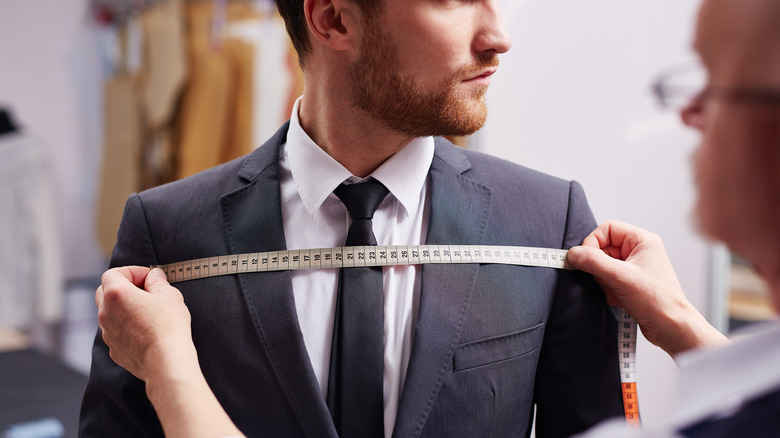What The High Fashion Industry Doesn't Want You To Know
When I think of the high fashion industry, I can't help but see images from The Devil Wears Prada. I imagine insanely thin models navigating a world of demanding editors, huge paychecks, and tiny salads. While this may not be entirely true, the inside world of the high fashion industry is loaded with misleading prices and secret practices.
From environmental concerns to reverse photoshopping, there is a lot going on behind the scenes. Here are just a few of the details the fashion industry would rather you not know.
How much sunglasses are marked up
I assume there is a large markup when it comes to high fashion, but never realized sunglasses are the biggest offenders. "Designer sunglasses have the highest markup at retail by far, think 800 percent in some cases. What's more, almost all designer brands are produced by the same two manufacturers, despite the big difference in price," Fashion Designer and blogger Mariana Leung told me. "Also, the designer rarely gets involved as this category is usually licensed out to a third party."
So next time you're tempted to splurge on the designer sunglasses, take a look at the outlet ones. There may not be a huge difference.
Beware the outlets
You may get similar sunglasses at the outlets, but that's where the deals stop. Outlets should be places to score out of season or slightly damaged designer clothes at a huge discount. Unfortunately, you're usually just getting a much less quality garment with the designer's name on it.
"Designer outlets are run separately. Yes, lesser quality materials, uglier colors, or just old styles are deliberately sold at the outlet malls. They are the stepchild of designer businesses, even if they bring in more money," explained Leung. "The designer's best work is sold in their boutiques. Department store buyers often buy the same, safe styles season after season. Then the same buyers charge back the designers if they don't sell. The one of a kind runway creations are more likely to be at the boutique where there is little pressure to meet a price point or sales volume."
If you've noticed this trend, then you're not alone. A group of Congress members wrote a letter to the Federal Trade Commission about their concerns of deception. "Historically, outlets offered excess inventory and slightly damaged goods that retailers were unable to sell at regular retail stores. Today, however, some analysts estimate that upwards of 85 percent of the merchandise sold in outlet stores was manufactured exclusively for these stores," they wrote. "Outlet-specific merchandise is often of lower quality than goods sold at non-outlet retail locations. While some retailers use different brand names and labels to distinguish merchandise produced exclusively for outlets, others do not."
Why your size changes
Ever wonder why your size changes from season to season? Maybe you just assume that you added a few extra holiday pounds, but it could be the clothes themselves. The industry changes the fit and size year to year.
"Always try on clothing. Just because something fit you one season, does not mean the same size will fit you the next," advised Leung. "Designers and fit models change. The overall aesthetic evolves. Manufacturers are not 100 percent precise for every garment. As a technical designer, I have measured thousands of garments, so I have the numbers to prove this is true. On that note, the 'size' on the label means nothing. Every brand has their own sizing, and there is no industry standard. Buy what you like, and what looks good on you."
So stop giving any of your power to the size in your clothing. It's bound to change and will look different depending on which store you shop in.
They want you to feel out of fashion
You know that feeling of walking out of the store with the absolute best pair of jeans ever? They feel amazing, and you just can't wait to wear them. Soon however, they're just another pair of jeans sitting in your closet. Why do they lose their magic so fast? That's all part of the plan.
"Once upon a time, there were two fashion seasons: Spring/Summer and Fall/Winter," Sustainable Fashion Designer Shannon Whitehead wrote for the Huffington Post. "Fast forward to 2014, and the fashion industry is churning out 52 'micro-seasons' per year." The fashion industry depends on you feeling out of style so that you go and buy more.
Some prey on models
The life of a model certainly looks exciting. Traveling the world while being surrounded with gorgeous people and having an enviable Instagram account does not exactly look grueling. However, there is a dark side to modeling, and the fashion industry is partly to blame. Too many models experience sexual harassment once they enter this world.
"When a girl is left alone with one person, it makes it easier for this to happen," Model and host of America's Next Top Model Aftershow Jackie Miranne told Fox News. "Castings are always safest when they take place in a more professional setting, such as the offices of a magazine or casting company."
Unfortunately models have to be aware of which fashion industry workers could be predators. "There a few big names in the fashion industry that are notorious for 'sampling' the models before they book the job. Basically, it comes down to a choice of whether you are willing to throw your principles overboard to accelerate your career," former model Ariane Sommer told Fox News. "It becomes more problematic, however, if the model in question is extremely young and impressionable. These girls often don't know how to stand up for themselves and are like a deer in the headlights."
Many don't pay their models well
I'm not usually in the habit of feeling bad for models, but I was shocked to learn how little they could be paid, even by high fashion houses. Their income is uncertain. "It's like nonstandard employment or jobs in the informal economy, in which you don't know when your next paycheck is coming. It's uncertain work," Fashion Model-turned Sociologist Ashley Mears told NPR. "It's unpredictable, it's insecure, and you don't get benefits like health care or a retirement package."
Mears explained that catalog work typically pays well, but if you want to shoot high fashion pieces, you may barely earn anything. "So shooting for a high-end editorial magazine may pay you a flat rate of $150 a day. It may pay you nothing. It may pay you in lunch," she explained. "Similarly, some of the catwalk shows, they might be fantastic for your image, but you might not get paid in cash. You might be paid in what's known as trade. So when you're paid in trade, you get to take home some clothes."
Walk in fashion week and help huge designers make money, then only walk away with an outfit? This doesn't feel quite right.
They turn their heads when models are too thin
This was by far the most concerning fashion secret when it came to the models. The high fashion industry has essentially created a world where models can never be thin enough.
Former editor of Australian Vogue Kirstie Clements told The Guardian just how dire the situation has become. "I was dressing a model from the US on a beauty shoot, and I noticed scars and scabs on her knees. When I queried her about them she said, nonchalantly: 'Oh yes. Because I'm always so hungry, I faint a lot.' She thought it was normal to pass out every day, sometimes more than once." Clements wrote.
The problem is that the fashion industry requires models to be sickeningly thin in order to fit into the pieces, but does not address the problem of models starving themselves. "It is the ultimate vicious cycle. A model who puts on a few kilos can't get into a sample size on a casting and gets reprimanded by her agency. She begins to diet, loses the weight, and is praised by all for how good she looks," explained Clements. "But instead of staying at that weight, and trying to maintain it through a sensible diet and exercise, she thinks losing more will make her even more desirable. And no one tells her to stop."
They rely on reverse photoshopping
So what happens when models become too thin? The fashion industry simply photoshops their pictures to make them look healthier. This practice has become more common as models are looking sicker and sicker. "I hate featuring very skinny models," Designer Johnnie Boden told former Cosmopolitan editor Leah Hardy for the Daily Mail. "We try to book models who are a healthy size, but we constantly find that when they come to the shoot a few weeks later, they have lost too much weight. It's a real problem."
The problem is that no one in the fashion industry is stopping this trend. Even fashion magazines are helping cover up the issue.
"I, too, have been part of the reverse retouching trend. When editing Cosmopolitan magazine, I also faced the dilemma of what to do with models who were, frankly, frighteningly thin," Hardy wrote in the Daily Mail. "Thanks to retouching, our readers — and those of Vogue, and Self, and Healthy magazine — never saw the horrible, hungry downside of skinny. That these underweight girls didn't look glamorous in the flesh. Their skeletal bodies, dull, thinning hair, spots and dark circles under their eyes were magicked away by technology, leaving only the allure of coltish limbs and Bambi eyes."
Your gemstone accessories are misleading
Another player in the high fashion world is the jeweler responsible for accessories and jewelry. Gemstone jewelers in particular may be purposely misleading their customers about where the gemstones came from.
According to Gemologist Eva Meijer, about 95 percent of rubies and sapphires are not quite natural. "The world of fashion is quite secretive when it comes gemstones, but once you know more about the background, it becomes more understandable," Meijer told me. "It's a common misconception that all gemstones are naturally mined from the earth, untouched beyond the cut and polish. I wish, but that's not the case, and also, would be impossible. Without treatments, there would virtually be no gemstone jewelry industry and you probably wouldn't be able to wear amethyst, citrine, blue topaz, aquamarine, emerald, ruby, and blue sapphire jewelry pieces, to name a few commonly treated gemstones."
Some gemstones are not natural at all and are actually known as synthetic gems. "These [are] the same as a natural gem in terms of chemical composition, crystal structure, optical properties, and appearance except that [they have] been made by humans," explained Meijer. "These synthetic stones are the ones you can call the 'fakes.' I'm not judging, it's perfectly alright to use them as long as you know they were made in a lab and they're cheap!" Talk with your jeweler about where she sources her gemstones and how they have been treated.
High fashion has taken a toll on the environment
The high fashion industry seems to be all about opulence and luxury. So caring for the environment was never high on the priority list. While designers are making an effort to switch to more sustainable materials and practices now, it does not undo decades of abuse. Major accessories brands like Gucci rely on leather for their handbags, belts, and shoes. This does not come cheap to the consumer or the environment. Cattle ranching requires a huge amount of natural resources like water to maintain. Then the leather has to be treated with chemicals.
Fortunately major changes are being made. "I honestly think the brands are doing what they're doing because they think it's good business," Gemma Cranston, of the Cambridge Institute for Sustainability Leadership, told the Washington Post. "They just see it as a step they now need to take to continue to produce high-quality garments."
While focusing on sustainability may be good practice, retail consultant Robert Burke isn't buying it. "Consumers look at luxury brands for exclusivity, quality and status. I'm not sure where sustainability fits in that pecking order," he told the Washington Post.
You don't need high fashion for custom clothes
The high fashion industry has always been the go-to when the wealthy wished to purchase custom clothes. However, times are changing. All you have to do is log into your Amazon account. Amazon now has a patent on a custom clothing manufacturing system that is almost completely run by machines. Everything is automated, then quality-checked at the end. Once the clothes are deemed ready to go, they are sent out. And how long do you typically have to wait for your custom-made clothes? How does a mere five days sound? Move over, fashion industry!
